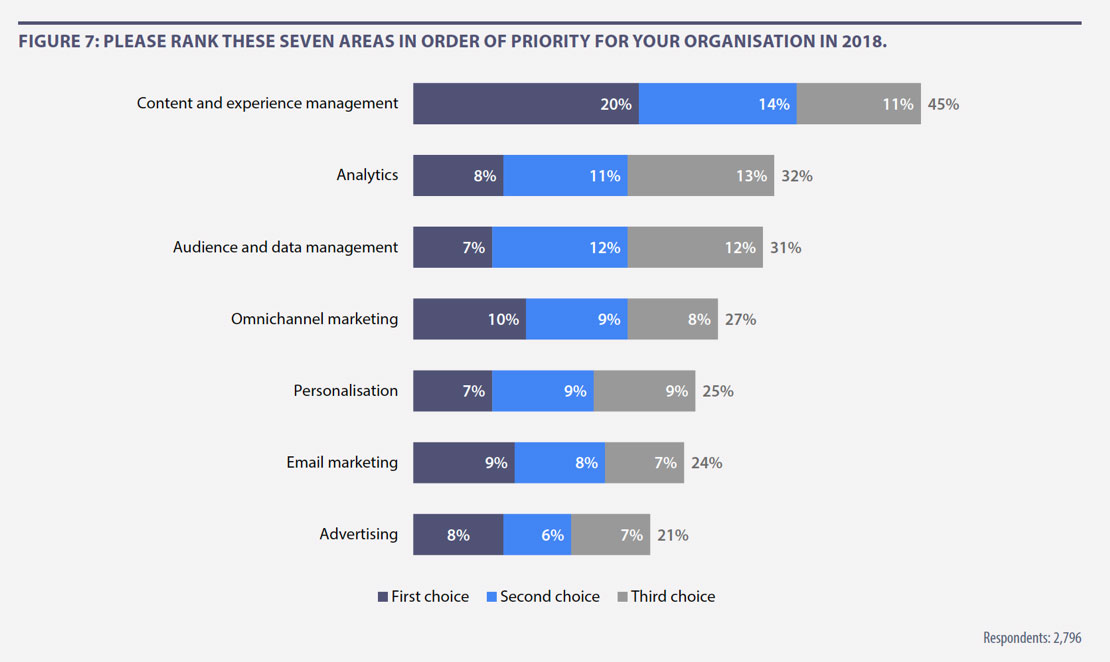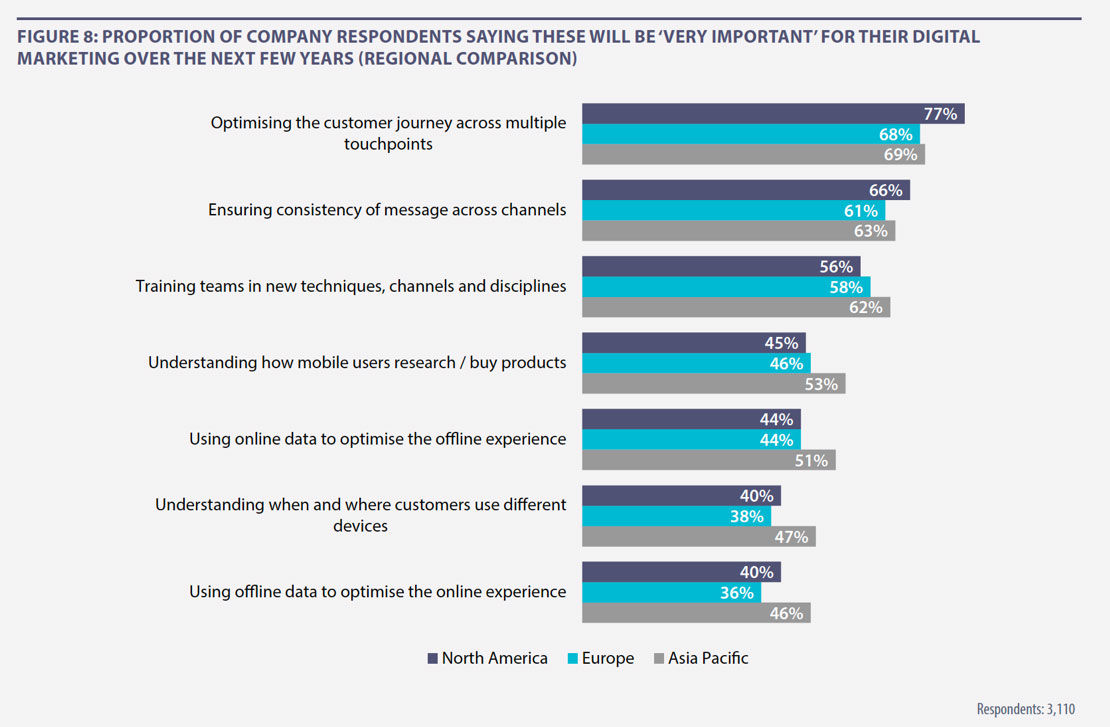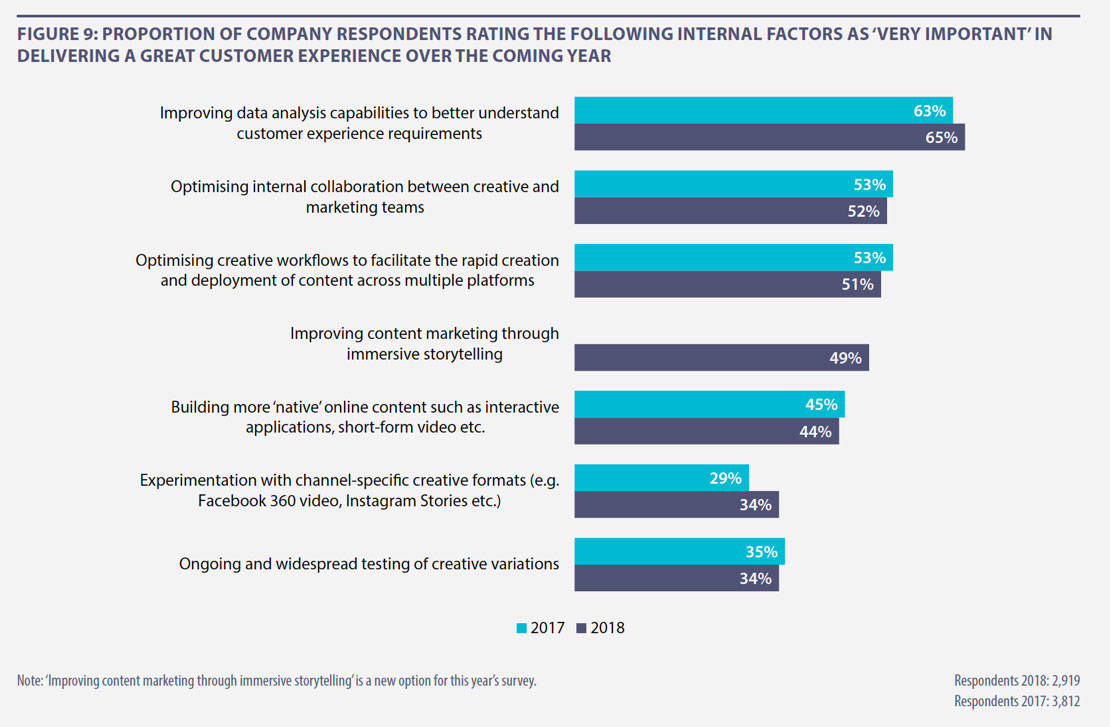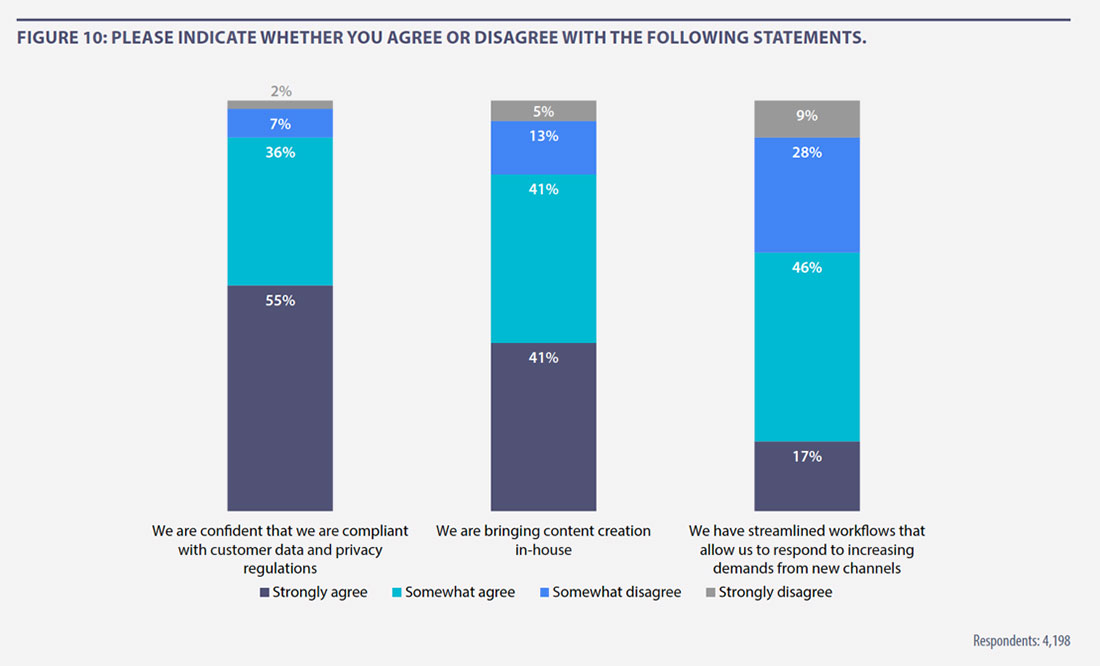Dual focus on content and data fuels UX and customer journey optimisation
The pivotal role of content in delivering a great CX has already been evidenced in this survey by the widely recognised opportunity to create compelling content for digital experiences (Figure 4).
The top strategic priority for organisations in 2018 is content and experience management (Figure 7), encapsulating the importance of harnessing content and media assets as effectively as possible to ensure the most effective interactions with customers and prospects. Almost half (45%) of companies surveyed rank this as one of their three most important priority areas for the year ahead, with a fifth (20%) stating that this is their primary focus. As a priority area, content and experience management is head-and-shoulders above all other areas, across all regions, including North America, Europe and Asia Pacific.
And this shouldn’t come as a surprise. Content is the lifeblood of marketing activities across a whole host of different touchpoints on owned and third-party digital properties, from website and advertising copy through to email marketing and social media activities. It is the fuel that drives digital experiences without which most businesses would eventually grind to a halt.

Although agencies can play an important role in helping their clients to develop compelling content, its increasingly strategic nature means that more organisations are seeing this as a crucial in-house competency. More than four in five (82%) respondents agree they are looking to bring content creation in-house (Figure 10). Organisations that are bringing content creation in-house are 29% more likely to have exceeded their top 2017 business goal by a significant margin (18% vs. 14%).
The next most important areas of priority for organisations are analytics and audience and data management, cited as top-three priorities by 32% and 31% of respondents respectively. The prominence of these data-related disciplines is a reminder that effective digital experiences are not possible without a strong foundation in data and analytics, to ensure that the content is being harnessed as effectively as possible, at the right time and through the right touchpoint.
Content and data need to work in unison for delivery of the best possible digital experiences. It is evident from Figure 8 that companies in the Asia Pacific region are particularly focused on a range of data-related capabilities, including understanding how mobile users research / buy products, understanding when and where customers use different devices, using online data to optimise the offline experience and vice-versa (i.e. using offline data to optimise the online experience).
Out of the disciplines shown in Figure 8, the need to orchestrate experiences effectively across different channels and points of engagement is seen as the most crucial. Optimising the customer journey across multiple touchpoints is regarded as ‘very important’ by 71% of marketers globally. In North America, this area of focus has assumed even greater importance, with more than three-quarters (77%) of respondents giving it a high-importance rating. Tellingly, the largest organisations are more likely to be prioritising this, with 81% of respondents at companies with more than £150m in annual revenues saying this will be very important, compared to only 69% of their counterparts at companies beneath this revenue threshold. The larger the company, the more difficult it can be to manage a multitude of different touchpoints often overseen by different teams in different countries.
These companies are right to be putting this discipline high on the agenda. Those organisations that ‘have well-designed user journeys that facilitate clear communication and a seamless transaction’ (see Figure 5) are 57% more likely than their peers to have exceeded their business goals by a significant margin (22% vs. 14%).

Key to the optimisation of the user journey across channels is the effective use of data, with around two-thirds (65%) of respondents saying that ‘improving data analysis capabilities to better understand customer experience requirements’ has been identified as an important internal prerequisite for CX success (Figure 9).
As part of the content imperative, there is also a focus on optimising creative workflows to facilitate the rapid creation and deployment of content across multiple platforms. Around half (51%) of marketers rank this as very important for their business, though this percentage has fallen from 53% last year. It is worrying that this figure has not climbed as it has become more crucial than ever for organisations – especially enterprise businesses – to be able to create, maintain and control workflows with minimum friction, as they strive to cater for growing content requirements across an ever-increasing array of channels and touchpoints.
Investment in integrated technology solutions can allow companies to automate, optimise and personalise at scale, in a way that simply isn’t feasible if you are relying on manual input to make this happen. The right processes and workflows are paramount, but only 17% of companies strongly agree they have ‘streamlined workflows that allow [them] to respond to increasing demands from new channels’ (Figure 10).
According to our research, organisations that ‘have tools that allow for streamlined workflows between creative and content marketers / web teams’ are 62% more likely to have exceeded their business goals by a significant margin (21% vs. 13%).


Data Access and Control
2018 has very much been on the radar for Europe-focused businesses as the year when the EU’s General Data Protection Regulation (GDPR) kicks in. Encouragingly, 91% of companies globally (and 89% in Europe) say they are confident that they comply with customer data and privacy regulations, compared to only 9% who say this is not the case (Figure 10). Only time will tell if companies are right to be confident about GDPR, or whether they have simply been burying their heads in the sand.
As was seen in Figure 5, just under two-thirds of respondents say that their organisations have ‘access and control over customer and marketing application data’, a capability that makes these organisations 62% more likely to have surpassed their business goals by a significant margin (21% vs. 13%).
Companies face an ongoing tension in trying to balance the growing requirement for data-driven marketing with the need for increasingly stringent data regulation. Control over customer-related data has become a hygiene factor for companies seeking to stay on the right side of the law, and is increasingly recognised as a capability that facilitates compliance rather than somehow jeopardising this. Accessible, user-friendly and joined-up marketing platforms make it much easier to ensure ‘the right to be forgotten’, by enabling the deletion of personal data from a company database on request.
GDPR does not prevent businesses from gathering and storing customer information, for example their browsing history, contact information or engagement with social media posts. It just means that consumers need to have provided an opt-in to having their data stored and used, and that they are fully informed about how their information will be used.
According to Ashley Friedlein, Econsultancy Co-founder and President of Centaur Marketing, 2018 will be a year in which marketers increasingly focus on ‘making sure they more directly collect and own customer and marketing data’.7
While privacy and regulation are an important consideration in the context of how companies organise themselves from a data perspective, the applications for data – and actual sources of data – are extremely broad-ranging.
According to Friedlein: “I believe data is the new digital. Just as digital became a ‘thing’, with its own teams, plans, budgets, job titles and board positions (Chief Digital Officer), in earnest around a decade ago, the same thing is happening with ‘data’ now. CDO is as likely to be Chief Data Officer as Chief Digital Officer. Expect dedicated data roles and teams and expect the same challenges around talent, silos, integration and matrix-working, that we have experienced, and continue to have, with ‘digital’.”